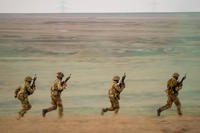Army Medicine audiology researchers are studying how hearing loss affects Soldier performance on the battlefield, giving commanders a better understanding of real-world limitations, and helping create a new, more realistic, standard for hearing profiles.
For more than 30 years, auditory fitness levels have been measured annually using an audiometry test, also known as the Defense Occupational and Environmental Health Readiness System Hearing Conservation, with a certain hearing-loss threshold prompting a mandatory medical review board.
So while many Soldiers have been labeled non-deployable because of hearing loss, the U.S. Department of Veterans Affairs, or VA, spends more than $1 billion in compensation per year to treat hearing loss for more than 800,000 veterans. Data collected by the VA shows as many as 52 percent of combat Soldiers have moderately severe hearing loss or worse, mostly because of the loud sounds associated with combat.
However, researches want to know if the audiometry test's long-established hearing profiles are an accurate measure of a Soldier's ability to move, shoot and communicate.
"We are working on a research protocol that is looking at the effects of hearing loss on Soldier performance in realistic battlefield scenarios," said Lt. Col. Amy Blank, an audiologist from Walter Reed National Military Medical Center.
Those realistic battlefield scenarios were in the form of team-level maneuvers across a wooded training area on Fort Campbell, which provided an ideal location for Blank and Benjamin Sheffield, a research audiologist from Army Public Health Center (Provisional).
"My partners in this research developed a hearing loss simulator, which Soldiers mount on top of their helmets," Blank said. "The device superimposes hearing loss through earphones inserted into the ears, allowing us to evaluate how well they are performing in a scenario where they have a start point, waypoints to obtain, and an endpoint."
Soldiers, from the 101st Airborne Division (Air Assault), donned the equipment and formed four competing teams, each of which simulated varying levels of hearing loss. The Army's current auditory fitness-for-duty system characterizes those levels as hearing profiles H1, H2, or H3, with the latter being the worst of the three profiles. Each team's mission was to navigate to each of three waypoints and reach their endpoints as quickly as possible.
"There are other teams on the battlefield and they have to engage teams if they come across them. The objective is to get from start to finish and be the first to arrive. That is difficult when we superimpose simulated hearing loss on the Soldiers," Blank said.
"We have a pretty sophisticated way of collecting data," added Sheffield, as he fitted helmets with video cameras, binaural microphones and hearing-loss simulation devices. "Through word of mouth and a bit of research, we found this HITS [Homestation Instrumentation Training] System here at Fort Campbell. We recognized this would be the perfect platform to move to the next step in our research. Also, we have the 101st Airborne here at Fort Campbell, a good unit well experienced in this type of combat."
In the proof-of-concept phase, Blank and Sheffield had performed similar tests on West Point cadets using paintball-based scenarios with the same hearing-loss simulators, but with a woodsball or "every man for himself" format.
The HITS system at Campbell opened up a new wealth of data possibilities, Sheffield said. HITS is an automated information system designed to support collective maneuver training and captures position and weapons effects data for real-time monitoring or playback. Inside a portable control room, Blank and HITS technicians monitored a wall of computer screens, where color-coded icons gave a birds-eye view of the action unfolding nearby on Fort Campbell's Camp Hinsch training area.
"It provides an opportunity for us to automatically monitor what is happening. They have the MILES [Multiple Integrated Laser Engagement System] gear and use their real weapons," Sheffield explained, noting that previous testing using paintball was limited because it was inherently quieter and just did not sound the same. "All of that affects our results. So, in terms of accuracy here, we know who is shooting who and when it is happening very precisely, and we also have a way of very easily tracking their movement."
In early studies, researchers saw a change in strategy as a function of hearing loss. "In the woodsball scenario," Sheffield said, "Soldiers in the more difficult hearing loss profiles tended to camp out or hide in order to maintain their survivability, but we saw a very significant drop off in their ability to engage the enemy. So, their lethality dropped off to half what it was in a normal hearing setting."
While the collected data will be studied for months to come, Sheffield said the research has already produced clear results.
"I can already safely say we are seeing trends that will hold up. We are definitely seeing that the normal hearing team is winning close to 40-percent of the rounds. There are four teams per round; chance would be 25 percent; and the severe hearing loss profile we are testing is winning less than 15 percent of the time. So we are definitely seeing a significant difference there. The mild to moderate losses we are testing fall between there, close to 25-30 percent," Sheffield said.
One Soldier participating in the study said the simulated hearing loss was an eye opener, prompting the use of other tactics.
"When I couldn't hear very well, it made me a lot more cautious. I felt like I needed to be more vocal to my Soldiers to my left and right. I couldn't tell if they could hear me or not, so it really affected our movement," said Sgt. Nimrud Velasco, 101st Airborne Division (Air Assault).
"There are a lot of things that surprised me on this testing. On setting number four, which is pretty much complete hearing loss, I had a hard time being able to direct where we were going or what I wanted the team to do to be able to continue the mission," Velasco said. "Being able to move to the objective is hard if you can't communicate effectively. You have to constantly look to your left and your right just to be able to communicate with the team leader and your Soldiers. It's tough."
In the end, Velasco said his team compensated by relying on hand-and-arm signals.
"Somehow, we got it done. You have to work with what you have and continue the mission," he said.
All of that could only be observed with this type of research, Blank explained.
"Lab derived testing is not real world. The sound they hear - the background noise - is not combat noise. This is a step in the process to make it more real world for the commanders on the ground so when their Soldiers are given a profile, they completely understand what that profile means and what the limitations are for that Soldier," Blank said.
Whether at war or at peace, hazardous noise is a prevalent occupational hazard in the Army and remains the most common military service-related injury reported by the VA. The intent of this research is to establish a standard for hearing loss profile that is more real world and realistic.
"Right now, when we profile Soldiers and they get to an H3 profile, it requires a medical board. Some of those Soldiers are released from service because of the amount of hearing loss they have," Blank said. "But none of that really is looking at how well a Soldier is localizing and functioning in an infantry type environment, detecting sound in a woods type environment. This is looking at more real-world experiences for the Soldiers."
Researchers Evaluate True Effects of Hearing Loss for Soldiers
© Copyright 2025 Army.mil/News. All rights reserved. This material may not be published, broadcast, rewritten or redistributed.










